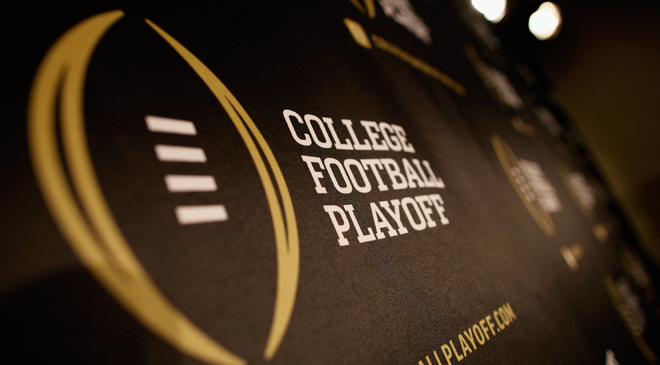I am not pleased with the College Football Playoff, though not for the reasons bounced around the echo chamber for the last few weeks.
Yes, the Playoff’s second installment featured some abysmal semifinals, but that’s not my concern. Neither is a dip in TV ratings. These are simply root causes of a more troubling element to the College Football Playoff’s existence.
It’s in just its second year, and already a din is growing for the system to be fixed.
I voiced some of my concerns in this feature piece on the history and significance of the Rose Bowl Game. The Granddaddy of ‘Em All’s place on New Year’s Day dates back to 1902, and yet one year of the College Football Playoff — one! Not even two! — is enough to prompt calls for changes.
Meanwhile, enough pundits and bloggers are fretting over Disney’s ratings that I’m starting to wonder if they aren’t Robert Iger’s investment team.
Ironic that the format intended to fix college football now needs fixing. I’m concerned the sport will be “fixed” to a point that it’s unrecognizable from the game I love, and more a bastardized version of the NFL. Parrish Walton nicely details why the differences between college football and the NFL are precisely why fans of the former enjoy it.
And yet, the more focused on the College Football Playoff those covering and running the sport become, the closer it inches to becoming New NFL. C-c-c-catch the wave!
Turning college football into another NFL without the fan bases, same collective level of talent and dare I say history would go over about as well as New Coke. Then the sport will be left trying to fix itself once again, only in trying to win back the hardcore fans as well as The Casual Fan™, at whose foot decision-makers now grovel.
I don’t tread on new ground invoking college basketball’s prominence in the sports landscape, but it bears reiterating. The 1990s were a Golden Age for the game. Starting in the 1980s and into the ’90s, the NCAA Tournament grew into a TV ratings bonanza, as well as a cash cow for CBS and the NCAA as a whole. The Tournament remains a huge TV hit, and it’s even more profitable today, thanks to the partnership between CBS and Turner Broadcasting.
However, “fixing” the game of basketball at various levels contributed to bigger problems from which the college game is only now starting to recover. One such example, the NBA opted to “fix” its problem of too many unskilled high schoolers declaring for the draft by implementing the One-and-Done Rule, which forced prospects who would have otherwise eschewed college to spend a year on campus.
The One-and-Done Rule contributed to a Lost Decade for college basketball, in which the quality of play plummeted and interest in the regular season waned.
As for the NBA’s grand solution, he flood of unskilled high schoolers entering the draft became a flood of unskilled college freshmen entering the draft. Only now, they did so after spending a year toiling on college rosters that struggled with chemistry.
The flaws of the One-and-Done have started self-correcting, and college basketball’s quality has improved by leaps-and-bounds with stars like Jared Uthoff and Buddy Hield staying and developing. And, in an admitted instance of “fixing” a sport actually working, changes to the shot clock and officiating have cultivated a more free-flowing style.
Nevertheless, the damage a decade’s worth of “fixes” inflicted on the game will take longer than one exciting season to correct.
Like college basketball in the ’90s, college football is presently in a Golden Age. Stanford head coach David Shaw said it best in November:
“There are a lot of good teams that are not going to the Playoff that need attention. The story is really how good college football is, and not just who’s going to the Playoff.”
The College Football Playoff is an improved method for crowning a national champion. None of the preceding is a plea to return to a system that arbitrarily deems Alabama more worthy of a title shot than Oklahoma State despite beating half as many ranked opponents, or that sends Oklahoma into the championship game despite not winning its conference.
If your sole concern is a three-game series designed for three percent of the entire Football Bowl Subdivision, then keep retooling. But the more college football is fixed for the sake of the College Football Playoff, the more likely it is to be damaged.


